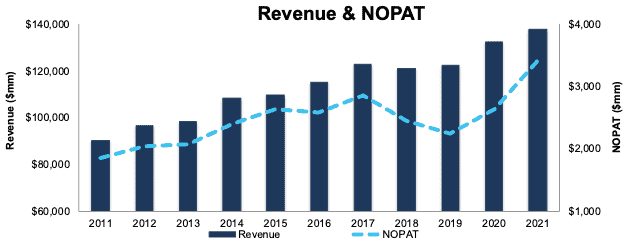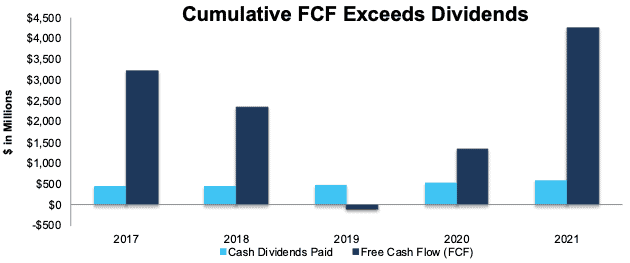Eleven stocks were added to our Dividend Growth Stocks Model Portfolio this month, which was made available to members on March 30, 2022.
Recap From February’s Picks
On a price return basis our Dividend Growth Stocks Model Portfolio (+0.5%) underperformed the S&P 500 (+4.1%) by 3.6%, and on a total return basis the Model Portfolio (+0.6%) underperformed the S&P 500 (+4.5%) by 3.9%. The best performing stock was up 23%. Overall, 8 out of the 30 Dividend Growth Stocks outperformed the S&P 500 from February 25, 2022 through March 28, 2022.
This model portfolio mimics an “All Cap Blend” style with a focus on dividend growth. Selected stocks earn an Attractive or Very Attractive rating, generate positive free cash flow (FCF) and economic earnings, offer a current dividend yield >1%, and have a 5+ year track record of consecutive dividend growth. This model portfolio is designed for investors who are more focused on long-term capital appreciation than current income, but still appreciate the power of dividends, especially growing dividends.
More reliable and proprietary fundamental data, proven in The Journal of Financial Economics, drives our research and provides investors with a new source of alpha. Our proprietary Robo-Analyst technology[1] scales our forensic accounting expertise (featured in Barron’s)[2] to produce an unrivaled database of fundamental data.
Featured Stock From March: The Kroger Company (KR: $60/share)
The Kroger Company (KR) is the featured stock from March’s Dividend Growth Stocks Model Portfolio.
Kroger has grown revenue by 4% compounded annually and net operating profit after-tax (NOPAT) by 6% compounded annually over the past decade. Kroger’s NOPAT margin improved from 2.0% in 2011 (FYE is 1/28/12) to 2.5% in 2021, while the company’s return on invested capital (ROIC) rose from 6% to 7% over the same time.
Figure 1: Kroger’s NOPAT & Revenue Since 2011
Sources: New Constructs, LLC and company filings
FCF Exceeds Dividends by Wide Margin
Kroger has increased its dividend each year since 2006. The company increased its regular dividend from $0.49/share in 2017 to $0.78/share in 2021, or 12% compounded annually. The current quarterly dividend, when annualized, equals $0.84/share and provides a 1.4% dividend yield.
More importantly, Kroger’s strong free cash flow (FCF) exceeds the company’s growing dividend payments. Kroger’s cumulative $11.1 billion (26% of current market cap) in FCF is more than 4x the $2.5 billion in dividends paid out from 2017 – 2021, per Figure 2. Figure 2 also shows that Kroger’s FCF significantly exceeded its dividend payments in four of the past five years.
Figure 2: Free Cash Flow vs. Regular Dividend Payments
Sources: New Constructs, LLC and company filings
Companies with FCF well above dividend payments provide higher quality dividend growth opportunities because we know the company generates the cash to support a higher dividend. On the other hand, the dividend of a company where FCF falls short of the dividend payment over time cannot be trusted to grow or even maintain its dividend because of inadequate free cash flow.
Kroger Has Upside Potential
At its current price of $60/share, KR has a price-to-economic book value (PEBV) ratio of 0.5. This ratio means the market expects Kroger’s NOPAT to permanently decline by 50%. This expectation seems overly pessimistic for a company that has grown NOPAT by 6% compounded annually over the past decade.
Even if Kroger’s NOPAT margin falls to 2.1% (five-year average vs. 2.5% in 2021) and the company grows NOPAT by <1% compounded annually for the next decade, the stock is worth $112/share today – an 87% upside. See the math behind the reverse DCF scenario.
Should the company grow NOPAT more in line with historical growth rates, the stock has even more upside. Add in Kroger’s 1.4% dividend yield and history of dividend growth, and it’s clear why this stock is in March’s Dividend Growth Stocks Model Portfolio.
Critical Details Found in Financial Filings by Our Robo-Analyst Technology
Below are specifics on the adjustments we make based on Robo-Analyst findings in Kroger’s 10-K:
Income Statement: we made $2.8 billion in adjustments with a net effect of removing $1.7 billion in non-operating expenses (1% of revenue). Clients can see all adjustments made to Kroger’s income statement on the GAAP Reconciliation tab on the Ratings page on our website.
Balance Sheet: we made $12.9 billion of adjustments (all of which increased invested capital) to calculate invested capital. The most notable adjustment was $6.6 billion (20% of reported net assets) related to goodwill. Clients can see all adjustments made to Kroger’s balance sheet on the GAAP Reconciliation tab on the Ratings page on our website.
Valuation: we made $24.6 billion in adjustments with a net effect of decreasing shareholder value by $24.6 billion. Other than total debt, the most notable adjustment to shareholder value was $1.6 billion in net deferred tax liabilities. This adjustment represents 4% of Kroger’s market value. Clients can see all adjustments to Kroger’s valuation on the GAAP Reconciliation tab on the Ratings page on our website.
This article originally published on April 8, 2022.
Disclosure: David Trainer, Kyle Guske II, and Matt Shuler receive no compensation to write about any specific stock, style, or theme.
Follow us on Twitter, Facebook, LinkedIn, and StockTwits for real-time alerts on all our research.
[1] Harvard Business School features our research automation technology in the case Disrupting Fundamental Analysis with Robo-Analysts.
[2] See how our models and financial ratios are superior to Bloomberg and Capital IQ’s (SPGI) analytics in the detailed appendix of this paper.


